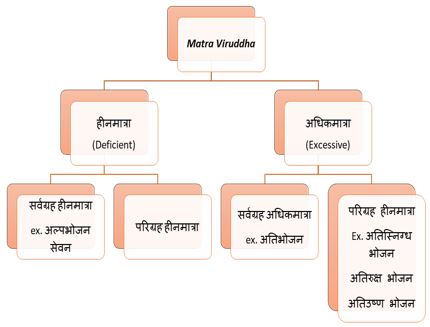Conceptual insights of Matravirudha Ahara in Ayurveda
DOI:
https://doi.org/10.21760/jaims.8.6.32Keywords:
Viruddhahara, Ama, Allergy, Twak Vikara, Matra ViruddhaAbstract
Ayurveda is something beyond a remedial framework; it is a science and specialty of reasonable living that guides in accomplishing life span. It puts an accentuation on deterrent and recuperating treatments notwithstanding various approaches to purifying and revival. It can assist every individual with coming to the right conclusions about their sustenance, way of life, and exercise to restore a good arrangement between their body, brain, and mindfulness, to restore a good overall arrangement between their body, psyche, and mindfulness, in this manner ending the spread of sicknesses. Some unacceptable eating routines, propensities, ways of life, contradictory food mixes (e.g., milk and fish, melons and grain, yogurt, and meat or cooked Madhu, and so on), occasional changes, curbed feelings, and stress variables can all act either together or independently to change the equilibrium of Vata, Pitta, and Kapha. As per the idea of the reason, either Vata, Pitta, or Kapha go through exacerbation or insanity which influences the Agni (gastric fire) and creates Ama (poisons). This Ama enters the circulatory system and is circled all through the body, stopping up the channels. Maintenances of poisons in the blood bring about pre-eclampsia. This gathered poisonousness, when deeply grounded, will gradually influence Prana (crucial life energy), Ojas (resistance), and Tejas (cell metabolic energy) and result in sicknesses. This can be nature's endeavor at killing the poisonousness from the body. Each supposed infection is an emergency of Ama poisonousness. Ama is the fundamental interior reason for all illnesses, due to the bothered Doshas.
Downloads
References
Sharma RK, Dash B. Charaka Samhita. Vol 1. Reprint ed. Chowkhamba Sanskrit Series Office, Varanasi. 2011: p. 485.
Sharma RK, Dash B. Charaka Samhita. Vol 1. Reprint ed. Chowkhamba Sanskrit Series Office, Varanasi. 2011: p. 485.
Sharma RK, Dash B. Charaka Samhita. Vol 1. Reprint ed. Chowkhamba Sanskrit Series Office, Varanasi. 2021: p.125.
Sharma RK, Dash B. Charaka Samhita. Vol 1. Reprint ed. Chowkhamba Sanskrit Series Office, Varanasi. 2021: p.132.
Sharma RK, Dash B. Charaka Samhita. Vol 1. Reprint ed. Chowkhamba Sanskrit Series Office, Varanasi. 2021: p.125.
Vidya Jadavji Trikamji Acharya. Sushruta Samhita with Nibandha Sangraha Commentary. Reprint ed. Chowkahamba Surbharati Prakashan, Varanasi. 2022: p.96.
Sharma RK, Dash B. Charaka Samhita. Vol 1. Reprint ed. Chowkhamba Sanskrit Series Office, Varanasi. 2021: p.125.
Sharma RK, Dash B. Charaka Samhita. Vol 1. Reprint ed. Chowkhamba Sanskrit Series Office, Varanasi. 2021: p.132.
Vidya Jadavji Trikamji Acharya. Sushruta Samhita with Nibandha Sangraha Commentary. Reprint ed. Chowkahamba Surbharati Prakashan, Varanasi. 2022: p.103-104.
Sharma RK, Dash B. Charaka Samhita. Vol 1. Reprint ed. Chowkhamba Sanskrit Series Office, Varanasi. 2021: p.54.
Sharma RK, Dash B. Charaka Samhita. Vol 1. Reprint ed. Chowkhamba Sanskrit Series Office, Varanasi. 2021; p.70.
Gaud B. Charaka Samhita. Vol III. Reprint ed. Rashtriya Ayurved Vidyapeeth, New Delhi. 2021: p. 359.
Gaud B. Charaka Samhita. Vol I. Reprint ed. Rashtriya Ayurved Vidyapeeth, New Delhi. 2021: p. 540.
Gaud B. Charaka Samhita. Vol III. Reprint ed. Rashtriya Ayurved Vidyapeeth, New Delhi. 2021: p. 505.















